I took everything, except you
“What makes me cry, is not only last night's wein.
What makes me lingering, is more than your tender
How far away still to go? You clasped my hand
What makes me stumped, is the struggling freedom
Separation is always in September, memory is sorrowful thought.
The green weeping willows in deep autumn, is kissing my forehead
In this small rainy city, I never forget you
Chengdu, I took everything away from here, except you” Zhao Lei
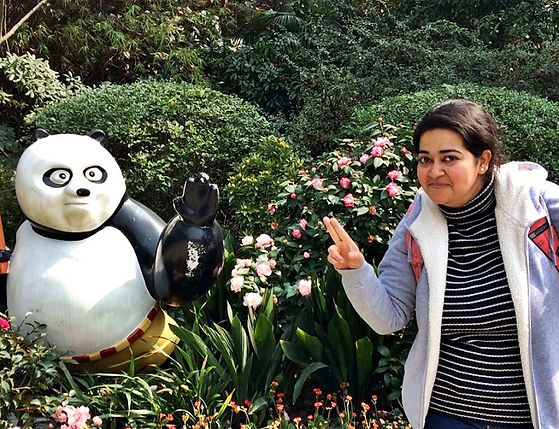




02/15/17-03/02/17
10
days
In February 2017 we as a family decided to have a 15 day leisurely vacation in China choosing the cities of Chengdu and Beijing as a part of the itinerary. Dad, a professor of South Asian economies, has been invited as a high end expert to the Institute of South Asian Studies, Sichuan University in Chengdu, China. Since we are spread over 3 different countries (Australia, China and India) it was a perfect opportunity to vacation as a family and also because there was something of interest for all of us on this trip. A common calling for all of us was of course the “FOOD” (you’ll know why).
Other interests being, my sister studying veterinary medicine came for the Pandas; my mum for being with the family (secretly she was eager to spend some more time with my sister, love for younger siblings I tell you *eye roll*) and me for the history and culture. The visit to Chengdu was a grand opportunity to live in one of the cities of gastronomy (2010) as identified by the UNESCO’s Global Alliance’s Creative Cities Network becoming the first in Asia to join the list and the second after Tucson, USA. Chengdu doesn’t really feature on a first timers’ China travel itinerary. But then again Vacilando-ing involves moving away from the ordinarily travelled paths.
Chengdu is the capital of southwestern China’s Sichuan province. It is most renowned for two things namely the Giant Pandas and the Sichuan cuisine. Sichuan food or what we sometimes also refer to as Szechwan food is steeped in flavor. It is most well-known for its hot and spicy flavor. So be prepared to have some mouth-numbing, oily, spicy and sweaty meals. Sichuan food is incomplete without the 3 most common and important ingredients that I fell in love with on this tour:
1. The mouth numbing hua jiao or Sichuan peppercorn. It’s not spicy or hot rather mouth-tingling and mouth-numbing with slight lemony overtones.
2. Fresh and dried red chilly peppers that are used liberally in all dishes.
3. The doubanjiang or fermented spicy broad bean paste which can be of two types with or without oil. The beans used in this are not soybeans rather the broad beans or what are also known as fava beans. The beans are fermented then mixed with fresh chillies and few other spices and then kept in earthen pots and allowed to further ferment. The price doubanjiang is said to vary with fermentation age (like wine I suppose). Here is a picture of a bottle of the doubanjiang that I got for myself to experiment with in my cooking.
Getting There
-
Visa: Rs.5000 per person (Rs. 8000 for express visa received on next working day) *may have changed after GST introduction
-
Flight from India to Chengdu: Singapore Airlines (via makemytrip)
-
Duration: 8 hours 10 minutes (Delhi to Singapore); 13 hr layover at Changi Airport; 4 hours 40 minutes (Singapore to Chengdu)
-
Return: 5 hours 5 minutes (Chengdu to Singapore); 3hr layover at Changi Airport; 7 hours 10 minutes (Singapore to Delhi)
-
Cost: Rs. 33,000
-
Cab from Airport to Sichaun University: CNY 40
Stay
-
Sichuan University Foreign Scholars' Apartment
Local Travel
-
Cabs are affordable and drivers easily understood our destinations written in Chinese (can get local people to help in translations)
-
Cab To Panda Centre: CNY 55
-
Cab From Panda Centre to Kuanzhai Alley: CNY 32
-
Chengdu Metro (Cheap & Easy to get around for solo/budget travelers)
Highlights
-
Kuanzhai Xiangzi (Broad & Narrow) Alley
-
Chengdu Panda Research Centre
-
Sichuan University
-
Tianfu Square
-
Wangjianglou Park (south bank of Jinjiang river)
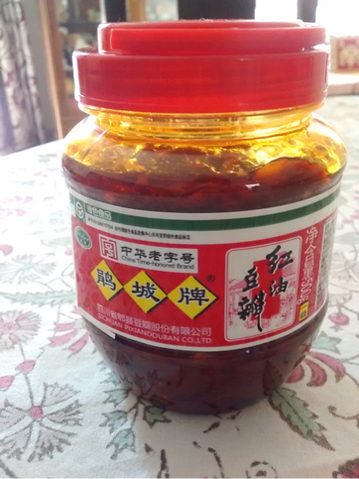
We spent close to 10 days in Chengdu of which most of the time was spent in eating :) In fact our first meal in the city was the Hou Gou (Hot pot). This I felt was a perfect meal to celebrate the coming together of our family in one city. Since you literally cook your meal together and enjoy the meal while sniffling and wiping off your sweat. LOL
The Sichuan hot pot usually uses what is referred to as the Mala sauce i.e. numbing, spicy and oily sauce which forms the base of the hot pot broth into which everyone keeps dunking their ingredients using chopsticks, letting the ingredients boil for a few minutes and then fishing out the ingredient and slurping the ingredient slathered with the hot broth and the mouth numbing chili oil. Sounds painful right but it is quite addictive!! You can opt for a half and half like we did (he he he) Check out the chilies in the spicy broth…phew!!

The ingredients that you can add to the broth are innumerable and you just choose what you want. We had quail eggs, thinly sliced beef, lamb, chicken, fish filets, prawns, fish balls, tofu skin, silken tofu, winter melon slices, lotus root, Chinese cabbage, bok choy, radish, bean sprouts, enoki mushrooms and some more. In fact, I had quite the introduction to the Sichuan cuisine as I almost choked on the cabbage slice that I chose to start with because as I gulped down the cabbage the Sichuan pepper hit me in the back of my throat and my eyes started watering and for a few seconds I thought I couldn’t breathe. So I chose to just happily dunk my ingredients in the non spicy broth but once the numbing tingling sensation in my mouth started going I wanted some more of the spicy broth. And ladies and gentlemen that is how one gets addicted to the hot and mouth-numbingly spicy Sichuan food.
Our second day was pre-planned and after our uncomfortable visits to the loo in the morning thanks to the hot pot dinner we all trudged out of the apartment to look for a taxi at 7:30am. It was imperative for us to reach the Chengdu Research Base of Giant Panda Breeding by 8-8:30 as my eager vet-student sister told us that it is the time when the Pandas are most active and most visible. The research base is about 30-40mins outside of the city and we took a taxi straight to the base. The entry was around CNY 540 and we paid an additional CNY 10 per person to take the battery operated vehicle to the top of the park hill. We decided to begin from the top so that it would be easier for us to explore the various enclosures and walk downhill. The research base is huge and there aren’t too many great places to eat and so we chose to carry some knick knacks as we had planned to have our next meal at the next destination on our day’s itinerary. We saw the pandas happily munching on their favorite bamboos, chilling on the trees, playing and eventually sleeping. The panda cubs enclosure is where my heart is still at!!!! My sister took some beautiful pictures of the Pandas while they were still active and you will realize the advantage of waking up early morning to go see these furries <3
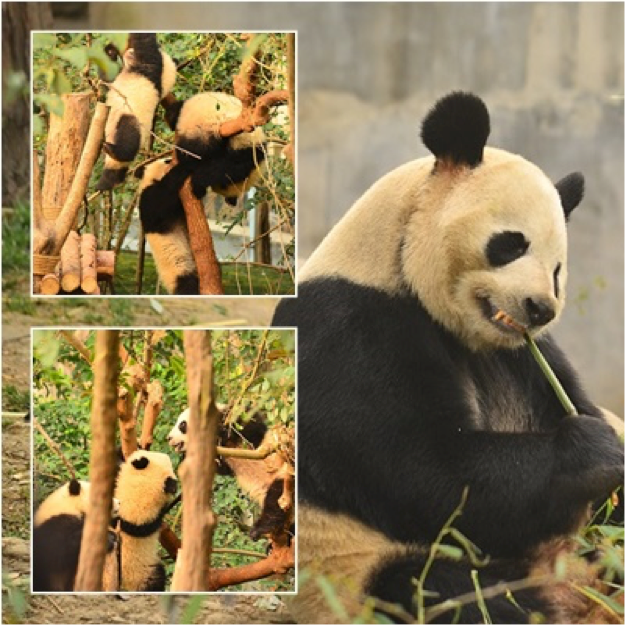
There is a museum within the base that explains how the research centre came up, there is another pit stop wherein you can understand the panda breeding process, then there is the panda kitchen where you can see the food for the pandas being prepared (reach here by 9:30 am or all you get to do is read the infographics and peep into the kitchen), there is a panda cinema where at certain time intervals a very informative hour long documentary is played with english sub-titles. There are souvenir shops where you can buy all the panda paraphernalia that you ever wish to own. If you are not a morning person then be prepared to give the panda centre a miss because if you get here any later than 10am then I’m afraid you wont be seeing much of the pandas.
After spending the morning at the Panda centre we moved onto Kuanzhai Xiangzi (Broad & Narrow) Alley. Consisting of Wide Alley (Kuan Xiangzi), Narrow Alley (Zhai Xiangzi), Well Alley (Jing Xiangzi) three parallel ancient city alleys and 45 courtyards along them, Wide and Narrow Alley is one of Chengdu’s historical and cultural reserves. I felt this was the best way to be introduced to the Chengdu way of life where you can leisurely walk through well maintained old alleyways and cobbled streets which have old houses with courtyards turned into souvenir shops, tea houses, restaurants, snack bars and street food stalls. It gets livelier in the evening. Within the complex there is also an old experiencing house wherein you can view the kitchen, living room, study and bedroom and visualize the daily life during olden days. What I enjoyed the most in this place was the multiple skewers and takeaway bowls of food that we gorged on.
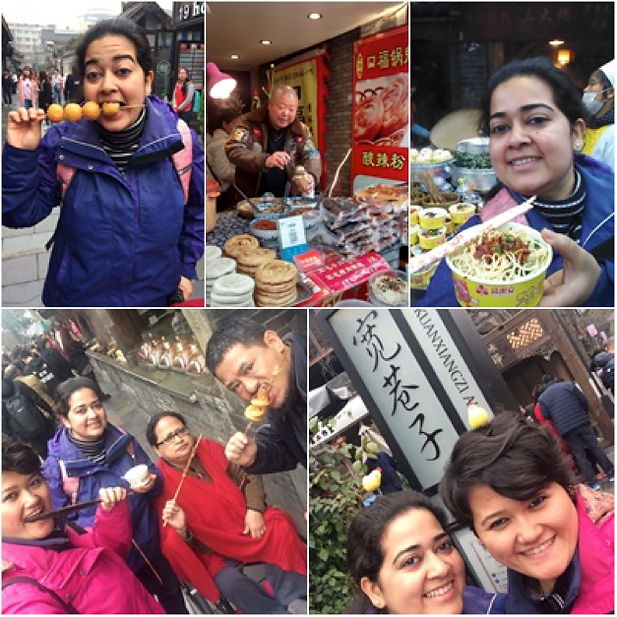
Being our second day in Chengdu this was a great way to be introduced to the Sichuan cuisine apart from the hotpot. My favourites were the chicken skewers, sizzling tofu, squid on sticks (all liberally dusted with a mix of crushed Sichuan peppercorn, chilli powder and salt), sweet sticky fried rice balls, dumplings, pineapple rice, dandan noodles and I may be forgetting some of the things we ate (we tried a lot of things). We spent the entire evening at this alley and finally went back to the apartment and crashed on our beds.
Next day we were too tired to do anything touristy so we decided to take things slow. Dad headed off to office and mum decided to rest. So me and my sister decided to explore the area just outside of Sichuan University and we began by first walking along the banks of the Jinjiang river which was a stone’s throw away from dad’s university provided apartment. After clicking considerable pictures we decided to explore the fresh meat and vegetable market just outside of the south gate of Sichuan University. We as a family are always excited about fresh produce and so me and my sister spent a considerable amount of time taking rounds of the market and even bought some vegetables (we did enjoy some homemade meals as well during our stay) and some fresh hand cut noodles (for dinner that same day) and some tofu.

The family had decided to get together for a lunch of some street side noodle soup and so at 1’o clock we all met at this one noodle joint inside the Sichuan University campus. This noodle joint had been frequented by my father many a times for lunch and so he was excited for us to try out the freshly made bowls of noodle. The lady running this shop works like a magician who begins by dunking your choice of noodles (thin, flat or sheet noodles) in some hot boiling water for a few minutes. The noodles are then tossed into a disposable bowl into which she adds the broth and various spices and condiments. You also get to choose from chicken, beef or pork chunks to be added to your bowl and whether you would like your bowl to be topped with a fried egg. Why I am describing this entire scene is because the lady does all the above mentioned activities while her eyes are glued to some Chinese drama (the sounds coming from her phone were quite melodramatic) playing on her smartphone next to her work area. It was unbelievable because she did not falter at any step and she did not mix up any of her orders.

And so we had a slow leisurely Chengdu-style day on our 3rd day in Chengdu. The next day we left for a week long visit to Beijing (which will require another blog post).
On our return to Chengdu we explored Tianfu Square which is the largest city square and a great place to shop around and also an important metro station as the Chengdu museum, Sichuan science & technology museum etc are all close by. A 10-15 minute walk from Tianfu takes you to People’s park which is another famous landmark in Chengdu.
Another favorite visit for me was to the Wangjianglou Park (on the south bank of Jinjiang river) where upon entering you are greeted by beautiful bamboo groves. Again this was also very close to the Sichuan University area and I was quite disappointed that we didn’t discover it sooner because then I would have gone there daily for leisurely walks. At the time of our visit the area near the bank of the river was blooming with flowers of lovely shades. It was a beautiful oasis in the middle of the bustling city.
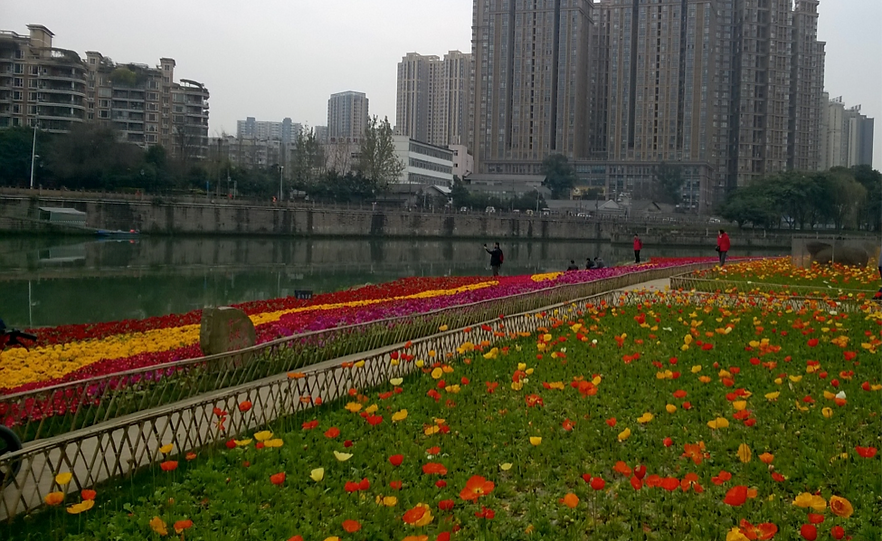
The entry to the park is free but entry into the different historical relics housed within the park is charged at CNY 20 each. The most famous is the Wangjiang Tower. The park and the tower were built to honor the woman poet Xue Tao (a poet in the Tang dynasty). Also since Xue Tao loved bamboo the park is said to house more than 150 varieties. On our walk in the garden we came across a tiny stream, some beautiful bridges, some huts made of bamboo and a huge water wheel also made of bamboo. The sights within the garden are beautiful and you can also see some people enjoying tea while playing Mahjong, some practicing Tai Chi, some practicing kite flying, etc etc.
My dad’s birthday was also celebrated in Chengdu and while he had to deliver a lecture and so he chose to stay back at home and prepare for his lecture while me and mom left to explore on foot. But before leaving I prepared some sticky rice and chicken and taro curry for my dad to enjoy before he left for his lecture. In the evening we had a special dinner planned at a beautiful restaurant where I enjoyed the best mapo tofu (silken tofu cooked in doubanjiang topped with hua jiao salt), Sichuanese style braised fish in doubanjiang (topped with lotus root, taro slices, chillies), Chinese greens and rice.

We were seated on a round table with a table wheel in the middle on which all the food was served. We had individual bowls of rice and we could just spin the wheel and pick at whatever dish we wanted with our chopsticks. All the food was enjoyed along with hot cups of jasmine tea. This was probably my best meal in China.
Some of the other meals that I enjoyed in Chengdu were the two lunches I had at the Sichuan university cafeteria, the Lanzhou beef noodles and liangfen (cold slices of mung bean jelly topped with hua jiao and chilli oil), Kung Pao Chicken (Cantonese in name however the Sichuanese twist is to add a lot of fresh and dried red chillies along with the quintessential peanuts) and a bowl clam rice-noodle soup. The beef noodle was enjoyed when me and mom decided to explore the area outside of the North gate of Sichuan University. While the Kung Pao Chicken was enjoyed at a hole in the wall restaurant outside of the West gate of Sichuan university as were the clam rice noodles. My top 5 favorite meals in Chengdu can be seen on my Instagram handle @november_child or simply visit this:
https://www.instagram.com/p/BRZ8VynD5exgwTamcT8oBqK-p3-R0HzCobTLso0/?hl=en&taken-by=november_child
The only Chinese that I learnt on this trip was Wei La (less spicy) and Xie Xie (thank you). Language can be a problem at times however since we always did our research before setting out from the house we had most language issues covered. As for explaining to taxi drivers our destinations we asked one of my dad’s students to write in Chinese all the spots we wanted to visit and also some basic directions. The same can also be done with the help of the reception staff at any of the hotels one stays at during their visit.
And that is how my visit to Chengdu ended eating gastronomic delights and enjoying the land of the red dragon. In the 10 odd days that I spent in Chengdu never once did I feel lost or uncomfortable and never once did my stomach give up on me. The city welcomes you with open arms and fills you up with good food like any mother. There is a vendor selling something yummy at every corner and there is a restaurant after every three shops or so. No wonder this city that stole my foodie heart has been crowned as one of the first gastronomic cities in Asia.
- Smritima Diksha Lama


